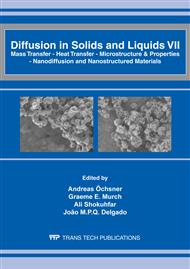p.111
p.115
p.120
p.126
p.132
p.141
p.147
p.153
p.158
Prediction of Effective Heat Storage Coefficient of Multi-Phase Materials
Abstract:
A theoretical model, to predict effective heat storage coefficient (HSC) from the values of HSCs of the constituent phases and their volume fractions for real two-phase systems is presented and is extended to three-phase moist materials, assuming an effective continuous medium (ECM) approach. Particles are assumed to be ellipsoidal in shape and arranged in three-dimensional cubic array. The arrangement has been divided into unit cells, each of which contains an ellipsoid. The HSC of the unit cell has been determined by applying resistor model. To take account of the non-linear flow of heat flux lines in real systems, incorporating an empirical correction factor in the place of physical porosity modifies an expression for HSC. An effort is made to correlate it in terms of the ratio of HSCs of the constituents and the physical porosity. To test the validity of the derived expression, the HSC of some building materials saturated with different liquids have been determined. The HSC of metal powders and metallic oxides at varying temperatures have also been determined. A good agreement has been found between the experimental and the predicted values reported in the literature.
Info:
Periodical:
Pages:
132-140
Citation:
Online since:
April 2012
Authors:
Price:
Сopyright:
© 2012 Trans Tech Publications Ltd. All Rights Reserved
Share:
Citation:


